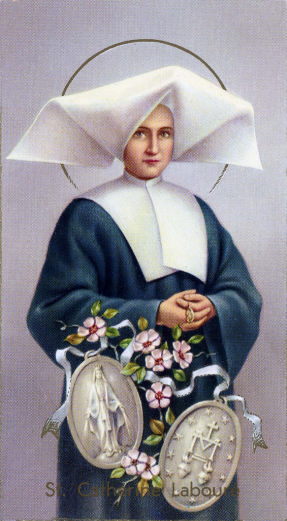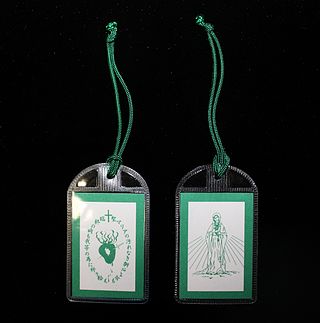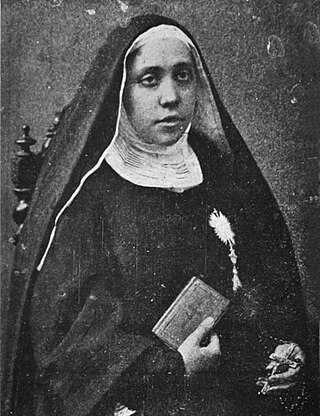
Catherine Labouré, DC was a French member of the Daughters of Charity of Saint Vincent de Paul and a Marian visionary. She is believed to have relayed the request from the Blessed Virgin Mary to create the Miraculous Medal, now worn by millions of people around the world. Labouré spent forty years caring for the aged and infirm. For this, she is called the patroness of seniors.

The Immaculate Heart of Mary is a Roman Catholic devotion which refers to the view of the interior life of Mary, her joys and sorrows, her virtues and hidden perfections, and, above all, her virginal love for God the Father, her maternal love for her son Jesus Christ, and her motherly and compassionate love for all mankind. Traditionally, the Immaculate Heart is depicted pierced with seven swords or wounds, in homage to the seven dolors of Mary and roses, usually red or white, wrapped around the heart.

Our Lady of Mount Carmel, or Virgin of Carmel, is the title given to the Blessed Virgin Mary in her role as patroness of the Carmelite Order, particularly within the Catholic Church. The first Carmelites were Christian hermits living on Mount Carmel in the Holy Land during the late 12th and early to mid-13th century. They built in the midst of their hermitages a chapel which they dedicated to the Blessed Virgin, whom they conceived of in chivalric terms as the "Lady of the place." Our Lady of Mount Carmel was adopted in the 19th century as the patron saint of Chile.

There are a number of Roman Catholic religious orders or congregations with Immaculate Conception in their name. Several of them are discussed here.
The Suor Orsola Benincasa University of Naples is a private university located in Naples, Italy. It was founded in 1895, named after the venerable sister Ursula Benincasa and is organized into 8 departments.

The Order of the Immaculate Conception, abbreviated OIC and also known as the Conceptionists, is a Catholic religious order of Pontifical Right for nuns founded by Saint Beatrice of Silva. For some years, they followed the Poor Clares Rule, but in 1511 they were recognized as a separate religious order, taking a new rule and the name of Order of the Immaculate Conception.

The Fivefold Scapular, also known as Redemptorist Scapular, is a sacramental made up of five best-known of the early scapulars in the Catholic Church: the Brown Scapular of the Carmelites, the Blue Scapular of the Immaculate Conception, the Black Scapular of the Servites, the Red Scapular of the Passion, and the White Scapular of the Most Holy Trinity. There are 17 total officially approved scapulars of the Catholic Church.

Beatrice of Silva, born Beatriz de Menezes da Silva, was a Portuguese noblewoman who became the foundress of the monastic Order of the Immaculate Conception. Amadeus of Portugal's younger sister, she is honored as a saint by the Roman Catholic Church.

Mary Potter, LCM was an English Catholic religious sister known for founding the Little Company of Mary in 1877.

The Green Scapular is a Roman Catholic devotional article approved by Pope Pius IX in 1870. It is called a scapular due to its appearance, but is not descended from the scapulars that form part of the habit worn by religious orders. It can be more accurately described as a "cloth medal". It is unique among Catholic scapulars, as it the only scapular which has only one badge of cloth, while all others have at least two.

The Blue Scapular of the Immaculate Conception is a devotional scapular that traces its roots to Venerable Ursula Benincasa, who founded the Roman Catholic religious order of the Theatine Nuns. This scapular must have a blue woollen cloth and on one side bears a symbolization of the mystery of the Immaculate Conception of Our Lady and on the other the name of the Blessed Virgin Mary.

The Scapular of the Sacred Heart is a Roman Catholic devotional scapular bearing an image of the Sacred Heart of Jesus on the front panel, and an image of the Virgin Mary as Mother of Mercy on the panel which hangs at the wearer's back. In its current form, the design and the formal church approval for its use are due to Estelle Faguette, a French domestic servant, who in 1876 claimed to have received a series of apparitions during which the Virgin Mary showed this scapular and spoke about its use.
Worldwide The Confraternity of the Immaculate Conception of the Blessed Virgin Mary is one of the oldest lay apostolates still operating in the Roman Catholic Church, having been part of the Congregation of the Marians of the Immaculate Conception founded by Stanislaw Papczynski. "The Blessed Marian Founder fervently encouraged his spiritual sons to establish confraternities of the Immaculate Conception at Marian churches. 'The first laws of the Order of 1694-1698 speak of this already."

The Column of the Immaculate Conception is a nineteenth-century monument in central Rome depicting the Blessed Virgin Mary, located in what is called Piazza Mignanelli, towards the south east part of Piazza di Spagna. It was placed aptly in front of the offices of the Palazzo di Propaganda Fide which houses the Congregation for the Evangelization of Peoples, as well as in front of the Spanish embassy as recognition by the pontiff of the defense that this nation has always made of this dogma of faith.

Our Lady of Pellevoisin is a title of the Blessed Virgin Mary which refers to a series of Marian apparitions in Pellevoisin, Indre, France. Pellevoisin is west of Châteauroux in the Catholic Archdiocese of Bourges.

Maria Cristina of the Immaculate Conception Brando, born Adelaida Brando, was an Italian saint, nun and the founder of the Congregation of the Sisters, Expiatory Victims of Jesus in the Blessed Sacrament, an international teaching institute. She was beatified by Pope John Paul II on 27 April 2003, and canonized by Pope Francis on 17 May 2015.

Santa Maria Egiziaca a Pizzofalcone is a Baroque-style, Roman Catholic, Basilica church on the street of the titular name in the hill of Pizzofalcone, in the historic center of Naples, region of Campania, Italy. The church layout was initially designed by Cosimo Fanzago.

Pietro de Marino was an Italian architect born in Naples and active there between 1629 and 1666. His works include the former church of San Potito.















